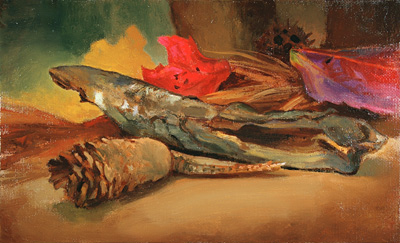
10/18.
It has been a mediocre week. I don't know where this piece is going and I'm sorry if I wrecked some portions that may have actually been ok previously. It has been like an ongoing color study, and I decided the fauvism is fine since it is an autumn piece after all. Thinking about how the subject amounts to little more than kindling made me think of this riddle I had read before, so the last few nights after painting I've been tinkering with a translation as a mental diversion:
Ic eom légbysig, láce mid winde,
bewunden mid wuldre, wedre gesomnad,
fús forðweges, fýre gebysgad,
bearu blówende, byrnende gléd.
Ful oft mec gesíþas sendað æfter hondum,
þæt mec weras ond wíf wlonce cyssað.
Þonne ic mec onhæbbe, hí onhnígaþ tó mé
monige mid miltse; þǽr ic monnum sceal
ýcan úpcyme éadignesse.
I am troubled by flame, sport with the wind,This is "Riddle 30," a difficult one and clumsy when translated. The answer is generally accepted as a tree (béam) with its compound meanings of "cross/ship/log" and its further use as a cup, bowl, or possibly a musical instrument.
wound with glory, one with the weather,
eager for departure, afflicted by fire -
a blooming grove, a burning coal.
Often friends pass me from hand to hand
so that men and women proudly kiss me.
When I rise up they bend down to me,
many with meekness; there I shall increase
the uprise of happiness among men.
Here the tree - and the "tree" on which Christ died - speaks, as it does in another poem called the Dream of the Rood and as other riddle subjects do, in the first person. (I'd meant to keep all mention of religion out of anything I write as I'm not a religious person, except when dealing with Old English where Christian themes are so common.) It undergoes wondrous transformations, shifting back and forth between a flammable ("lightning-busy"?) flowering tree and the various uses of its wood, seemingly unconnected and in confusing chronology. "Eager for departure [the journey forth]," describing possibly a ship, has also been seen as a warrior kenning for "ready for death" - which reinforces the shift back to a log or ember in the fire, as well as foreshadowing the notion of the cross. From there it shifts to a more personal hand-crafted object going "from hand to hand" connecting people in everyday ritual. Ultimately it takes on its highest purpose as the cross of the Crucifixion – or a crafted symbol of it, the highest form of art and something that touches all members of society. In all, this could be meant as an illustration of how God is present in all things and how "[n]o other power but God’s can connect the unconnected things of the earth and the unrelated events in time" (S. L. Higley, Between Languages).
But it's very ambiguous - that is, to us today. The third half-line is usually taken to mean the glory or splendor of a tree’s brilliant foliage (which is then possibly "gathered by the weather" if you prefer a different translation). But perhaps it also implies the glory of being the Lord's chosen tree. Maybe it refers to a ceremonial cross typically adorned with gold, silver and jewels, or even an allusion to the Dream of the Rood or similar story in which the true cross is similarly decked out and surrounded by light (another sort of "beam"). These old poets were cræftig.



1 comment:
Thank you for sharing the Old English words and riddles...fascinating stuff! Plus, your artwork is really beautiful...it's a treat to come visit you!
Post a Comment